Please bookmark this page and do come back from time to time, to see it growing. Thank you!
Select Page of the Album:Aproximately 100 houses have been excavated on Delos. Research has shown that, at some point, the population of the islet reached approximately the number of 30,000, thus the need for multi-storied edifices is obvious. The main and most interesting of the houses follow the type, common in Hellenistic times, of the house developed around a central court, frequently surrounded by columned porticoes. The rooms are ranged around the court, which is the source of light and air. Mosaic pavements adorned the court and/or the rooms in the wealthier homes. The central hall (Oecus Major) was undoubtedly the first one to receive special attention and be equipped with decorative mosaic pavements. The walls of the typical Delos home are built of schist slabs and more rarely of sun-dried bricks and covered with lime plaster (stucco) which sometimes had architectural features and painted representations. Parts of these are on exhibit at the local museum and shown in our relevant page of this album.
This page of the album will be enriched in the future.
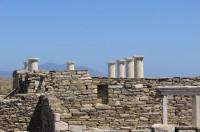
The House of Dionysus as seen from the Theater
The eight columns of the house are visible behind the wall. |
|
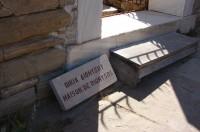
The House of Dionysus (Theater Quarter)
The sign by the entrance gateThe House of Dionysus, located in the Theater Quarter, is a good example of a private residence dating from the last quarter of the 2nd century BC. A covered passage leads from the entrance to a peristyle court, on which open the rooms of the ground floor. At the center of the court there is a cistern for the collection of water (inpluvium), covered with a splendid mosaic floor. A stone stairway leads to the elegant private rooms of the upper story. The columns of the peristyle are 5.6 m high. The most famous feature of the House of Dionysus is the exceptional emblem at the center of the mosaic pavement in the court depicting the god Dionysus, with outstretched wings and ivy wreath, mounted on a panther with a wreath of vine branches and grapes around its neck. In his right hand the god grasps the beribboned thyrsos as if it was a spear. (Please check our Archaeological Museum page in this album for some detailed photos of this masterpiece) |
|
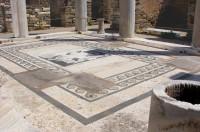
The House of Dionysus (Theater Quarter)
The inner yard with the pillars around the mosaic pavement, representing Dionysus riding a panther |
|
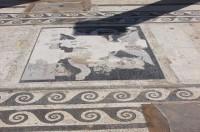
The House of Dionysus (Theater Quarter)
The central decorative work with Dionysus riding a panther, unfortunately under a parching sun and intruding black shadows. Much better photos are shown in the Archaeological Museum page of this album. |
|
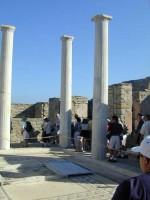
The House of Dionysus (Theater Quarter)
People admiring a copy of the exquisite mosaic of 'Dionysus riding a panther' decorating the inpluvium in the peristyle court. The original is exhibited in the archaeological museum on the island. |
|
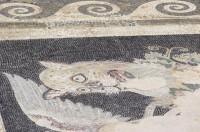
The House of Dionysus (Theater Quarter)
The central decorative mosaic (Detail) |
|
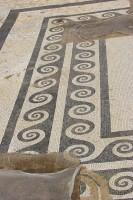
The House of Dionysus (Theater Quarter)
The decorative border of the main mosaic decoration in the peristyle court. |
|
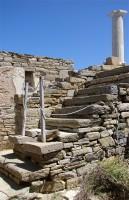
The House of Dionysus (Theater Quarter)
A stone stairway leads to the elegant private rooms of the upper story. |
|
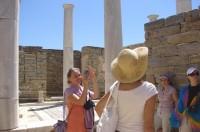
The House of Dionysus (Theater Quarter)
In the Entrance Arcade of the House, listening to our guide |
|
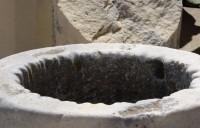
The House of Dionysus (Theater Quarter)
The ancient opening to the undergound cistern. |
|
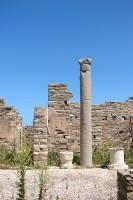
The House of Dionysus (Theater Quarter)
More rooms of the house |
|
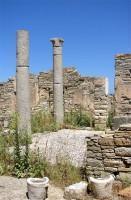
The House of Dionysus (Theater Quarter)
More rooms of the house |
|
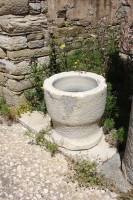
The House of Dionysus (Theater Quarter)
Marble water container(?) in the court |
|
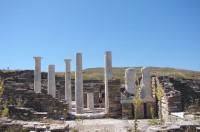
The House of Cleopatra (Theater Quarter)
The House of Cleopatra is opposite the House of Dionysus. It is named after the headless statues of the Athenian lady, Cleopatra, and her husband, Dioskourides, standing on the pedestal (138/7 BC.). |
|
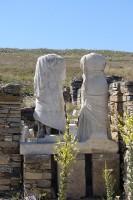
The House of Cleopatra
The statues of Cleopatra and Dioskourides, photographed from behind, standing on the pedestal (138/7 BC.). |
|
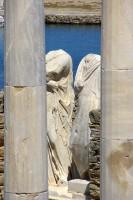
The House of Cleopatra
The statues of Cleopatra and Dioskourides half-hidden behind the columns of their own house |
|
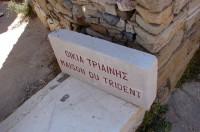
The House of the Trident (Theater Quarter)
A little higher up from the House of Cleopatra, is the House of the Trident. The sole opening into the house is the front door. Opposite the door, at the far end of the court, is the main room, the oikos or andron (men's room). The other rooms and the ancillary areas, kitchen, bathroom, latrine, are shared on the other side of the court. The colonnade on the north side, in front of the main rooms, is higher than the others, so as to admit more light to the andron yet protect it from the cold north winds. The difficulty of connecting the porticoes of unequal length was overcome by adding consoles to the taller corner columns, on which the architraves of the lower lateral porticoes rested. These consoles, sometimes plain like the ones in the House of the Mask, are here ornamented with lion and bull heads, which are considered to be emblems of the Syrian deities Atargatis and Adad. For this reason, it is hypothesized that the house belonged to a merchant from far-off Syria. |
|
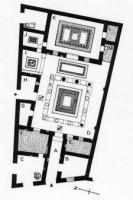
The House of the Trident (Theater Quarter)
The house plan |
|
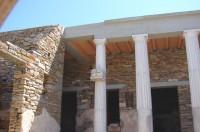
The House of the Trident (Theater Quarter)
Opposite the door, at the far end of the court, is the main room, the oikos or andron (men's room). The colonnade on the north side, in front of the main rooms, is higher than the others, so as to admit more light to the andron yet protect it from the cold north winds. |
|
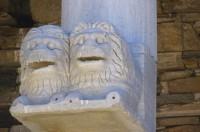
The House of the Trident (Theater Quarter)
The difficulty of connecting the porticoes of unequal length was overcome by adding consoles to the taller corner columns, on which the architraves of the lower lateral porticoes rested. These consoles are ornamented with lion and bull heads. |
|
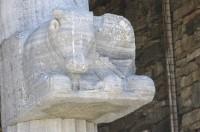
The House of the Trident (Theater Quarter)
The difficulty of connecting the porticoes of unequal length was overcome by adding consoles to the taller corner columns, on which the architraves of the lower lateral porticoes rested. These consoles are ornamented with lion and bull heads. |
|

The House of the Trident (Theater Quarter)
An emblem from the mosaic floor in the main reception rooms in the House of the Trident. It depicts a trident, after which the house is named, embellished with ribbons. The trident is one of the favorite motifs used in mosaic floors on Delos. The trident emblem is located in the middle of the north side of the peristyle. |
|
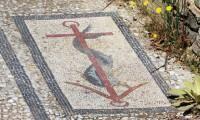
The House of the Trident (Theater Quarter)
Another detail of the fine mosaic, with a wonderfully executed, complicated and colorful meander pattern, in the impluvium of the court of the House of the Trident. One of the emblems from the mosaic floor in the main reception rooms in the House of the Trident. It depicts an elegant dolphin swimming around an anchor, a symbol frequently encountered on Delos. The dolphin emblem adorns the middle of the south side of the peristyle. |
|
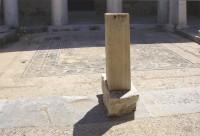
The House of the Trident (Theater Quarter)
The main mosaic pavement in the impluvium. This was a kind of shallow pool, mainly used to collect rain water from an opening in the roof so that it eventually flows into the underground cistern. During the summer, a small amount of water was kept in it which, besides strenghtening the colors, also kept the house cooler. It has a pattern with waves and a meander around the main decorative theme, which, unfortunately, is gravely destroyed. |
|
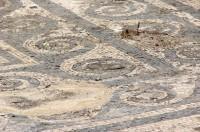
The House of the Trident (Theater Quarter)
The pattern with waves around the main decorative theme. (Detail-SW corner) |
|
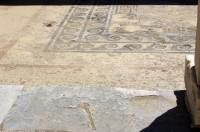
The House of the Trident (Theater Quarter)
The NW corner of the prementioned pavement |
|
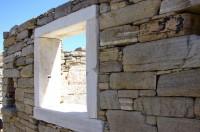
The House of the Trident (Theater Quarter)
A teller window, perhaps of a bank's or theater ticket seller's, to the right of the front gate, if we stand facing it. The colored plaster on the inner walls is decernible through it. Also decernible, to the far left of the photo, is the opening of the outer gate of the house. |
|
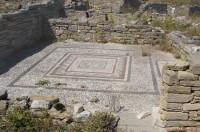
Delos House III N (Theater Quarter)
One of the mosaic pavements of the house under the code name III N. Please note that it does not belong to the central court. |
|
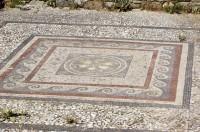
Delos House III N (Theater Quarter)
The mosaic pavement of the house under the code name III N |
|
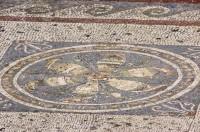
Delos House III N (Theater Quarter)
The central decorative theme of the same pavement |
|



